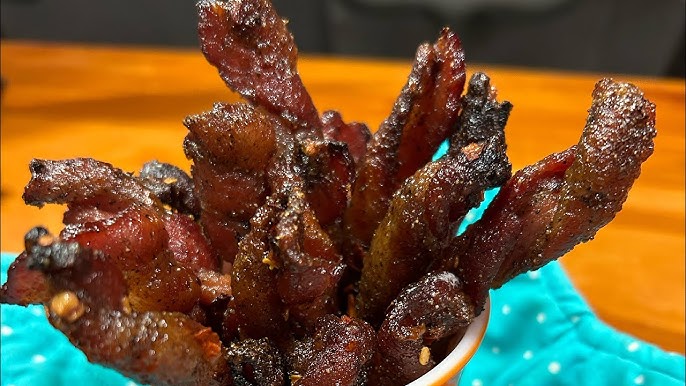Oven Bacon Recipe: If you’ve ever stood over a hot frying pan dodging bacon grease splatter, you’re going to love this method. Oven-baked bacon is the mess-free, no-fuss way to get deliciously crispy bacon every time. No flipping, no splashing oil, and best of all, you can cook a whole pack of bacon all at once. Whether you’re prepping for Sunday brunch or adding a crunchy topping to your salad, learning how to cook bacon in the oven is a game changer.
The oven method also lets you multitask—while the bacon cooks itself to perfection, you can whip up eggs, toast, or just enjoy your coffee. Once you try baking bacon, you’ll probably never go back to the stovetop. Let’s dig into why this method is such a fan favorite and how to get it just right.
Why Choose the Oven Method Over Stovetop?
So what makes oven-cooked bacon so much better than the stovetop version? First off, it’s hands-free. No babysitting the skillet or dodging grease burns. Just lay it out and bake—it’s that easy. It also gives you a more even cook. On the stove, some strips get crispy while others stay floppy. In the oven? Every piece comes out evenly cooked.
Another bonus? Less mess. Cooking bacon in the oven keeps the grease contained on a foil-lined pan or parchment paper, making cleanup a breeze. And if you’re cooking for a crowd, you can do it all in one go—no need to cook in batches like you would in a pan.
Plus, if you want to save that bacon grease for other recipes (like cornbread or sautéed veggies), the oven method makes it easy to pour and store. Whether you like your bacon chewy or extra crispy, the oven gives you full control.
Tools and Ingredients You’ll Need
Essential Tools
To make oven bacon, you really don’t need anything fancy. Here’s what you’ll want to have on hand:
- Rimmed baking sheet – to catch all the grease and prevent spills
- Aluminum foil or parchment paper – for easy cleanup
- Cooling rack (optional) – to elevate bacon for even crisping
- Tongs – to handle hot bacon safely
- Paper towels – to blot excess grease after baking
Ingredients
You only need one main ingredient—bacon! But not all bacon is created equal. Choose a type that matches your taste:
- Regular sliced bacon – cooks quicker, gets nice and crispy
- Thick-cut bacon – takes longer but has a chewy, hearty bite
- Flavored bacon (maple, peppered, etc.) – adds a fun twist
Pro Tip: If you want to make candied bacon or add a spicy kick, you can mix a little brown sugar, black pepper, or cayenne into your slices before baking.
How to Prep Your Oven and Pan
Choosing the Right Pan
For the best results, use a rimmed baking sheet. The rim keeps the bacon grease from dripping all over your oven. If you have a wire rack, place it inside the pan to elevate the bacon. This lets air circulate all around the slices, helping them cook evenly and get extra crispy.
Preheating the Oven
Preheat your oven to 400°F (200°C). This temperature is the sweet spot—it cooks the bacon evenly without burning. You don’t need to wait forever; just get it hot enough so the bacon starts cooking as soon as it hits the oven.
You might be tempted to start with a cold oven, but preheating ensures a more consistent result. If you’re using parchment paper, make sure it’s rated for high heat—most types are safe up to 425°F.
Step-by-Step Instructions for Perfect Oven Bacon
Step 1: Line the Baking Sheet
Start by lining your baking sheet with aluminum foil or parchment paper. This makes cleanup quick and easy. If you’re using a wire rack, place it on top of the foil-lined pan. The rack lets the bacon fat drip away and air flow underneath, giving you evenly crisped strips.
Step 2: Arrange the Bacon
Lay the bacon slices in a single layer on the pan or rack. Don’t overlap them—give each strip some space to cook. If you overcrowd the pan, the bacon will steam instead of crisp up.
If you’re using thick-cut bacon, leave a little extra space between strips since it releases more fat as it cooks.
Step 3: Bake the Bacon
Pop the pan in the preheated oven and set a timer. Regular bacon will take about 15 to 18 minutes, while thick-cut bacon may need 20 to 25 minutes. Keep an eye on it toward the end—bacon can go from golden brown to burnt pretty fast.
Want it extra crispy? Leave it in a minute or two longer. Like it chewy? Pull it out a bit earlier. Just remember, bacon keeps cooking a little after you take it out of the oven, so plan for that.
Step 4: Drain and Serve
Use tongs to transfer the hot bacon to a plate lined with paper towels. Let it sit for a minute or two to drain off excess grease and crisp up. Then dig in!
How Long to Cook Bacon in the Oven
Cooking bacon in the oven is pretty straightforward, but timing is everything. How long it takes depends on two things: the thickness of your bacon and how crispy you like it.
For regular-cut bacon, bake it at 400°F (200°C) for about 15–18 minutes. If you prefer it chewy, start checking at 12 minutes. For those golden, crunchy edges, let it go the full 18 minutes or even up to 20.
If you’re using thick-cut bacon, it’ll need a bit more time—typically 20–25 minutes. Don’t forget that all ovens are slightly different, so you may need to experiment a little to find your perfect bacon time.
Here’s a quick guide:
| Type of Bacon | Cooking Temp | Time Range | Result |
|---|---|---|---|
| Regular-cut | 400°F | 15–18 minutes | Crispy |
| Thick-cut | 400°F | 20–25 minutes | Meaty & crispy |
| Flavored (Maple) | 400°F | 15–18 minutes | Sweet & sticky |
Always keep an eye on your bacon toward the end—there’s a fine line between crispy and burned. Once it starts to bubble and curl up slightly, you’re almost there. Just a minute or two more and it’ll be perfection!
How to Get Bacon Extra Crispy
Want that restaurant-style, shatter-in-your-mouth crispiness? There are a few little tricks to push your oven bacon to the next level.
- Use a wire rack: Elevating the bacon lets hot air circulate all around it. This ensures even cooking and gives that crispy finish you’re after.
- Don’t overcrowd: Space is key. If the slices are overlapping or touching, they’ll steam instead of crisp.
- Blot the grease halfway through: Carefully dab the top of the bacon with a paper towel (use tongs!) around the 10-minute mark. This removes excess grease and helps it crisp faster.
- Try lower heat for longer: If you’re not in a rush, bake at 375°F for 20–25 minutes. The slower cook helps render the fat without burning.
- Flip if needed (optional): Flipping isn’t necessary, but for super crispy bacon on both sides, give it a turn halfway through cooking.
When it’s done, transfer the bacon to a paper towel-lined plate right away to stop the cooking and soak up any extra grease. Within a minute or two, you’ll have bacon so crispy it practically snaps.
Cleaning Up After Cooking
Nobody loves cleaning up, but oven bacon makes it way easier than stovetop splatter-fests. Here’s how to deal with the mess fast:
- Use foil or parchment: If you lined your baking sheet, just let it cool and toss the liner. Easy peasy.
- Let the grease cool: Don’t try to pour hot bacon fat into anything. Wait until it cools, then pour it into a jar for reuse or toss it.
- Wipe with paper towels: Any stubborn grease on the sheet can be wiped off before washing.
- Degrease the rack: If you used a wire rack, soak it in hot soapy water for 10–15 minutes. A scrub brush will take care of any stuck-on bits.
Tip: Save the bacon grease! It’s liquid gold for cooking eggs, roasting veggies, or adding rich flavor to savory dishes.
Storing Leftover Bacon
If you manage not to eat it all in one go, storing bacon is super simple. Let it cool completely, then stash it in an airtight container or a ziplock bag.
- In the fridge: Keeps for up to 5 days
- In the freezer: Lasts for about 1–2 months
To reheat:
- Microwave: Wrap in a paper towel and zap for 20–30 seconds.
- Skillet: Reheat on low heat until warm and crispy.
- Oven: Bake at 350°F for 5–10 minutes if you’re reheating a large batch.
Want to meal-prep your mornings? Make a big tray of bacon and keep it in the fridge for breakfast wraps, salads, or quick snacks all week.
Creative Ways to Use Leftover Bacon
Leftover bacon isn’t just for sandwiches (though, let’s be honest, BLTs never get old). Here are some delicious and clever ideas to use those crispy bits:
- Chop it and toss into salads – Caesar, Cobb, or even a simple garden salad
- Add to scrambled eggs or omelets for a savory punch
- Crumble over baked potatoes or mashed potatoes with a little sour cream and cheese
- Mix into mac & cheese for a smoky twist
- Top your burgers or grilled cheese sandwiches
- Make bacon-wrapped anything – shrimp, asparagus, jalapeños
- Stir into soups and stews for an added depth of flavor
Feeling sweet and salty? Try adding bacon to chocolate chip cookies or sprinkle on top of maple cupcakes. It sounds wild, but bacon’s smoky, savory edge pairs surprisingly well with sweets.
Tips for Success
Want to get your oven bacon perfect every single time? These pro tips will help you master the method with zero stress and max results:
- Start with a cold pan: Laying bacon on a cold pan before baking helps it render fat more evenly. The gradual heat makes it cook more uniformly.
- Use center oven rack: Baking bacon in the center of the oven gives it the most consistent heat. It’s less likely to burn on the bottom or overcook at the edges.
- Watch it at the end: The last 2–3 minutes are crucial. That’s when bacon can go from “almost done” to “scorched” if you’re not paying attention.
- Tailor the time to your texture preference: If you like chewy bacon, pull it out sooner. If you want it crispy, leave it in a bit longer.
- Rotate your pan: If your oven has hot spots (and most do), rotating the baking sheet halfway through cooking can help all slices cook evenly.
Remember, bacon keeps crisping slightly after it’s out of the oven—so take it out a tiny bit before your ideal doneness. Mastering the small things can take your bacon from “pretty good” to “OMG amazing.”
Common Mistakes to Avoid
Even with such a simple recipe, it’s easy to slip up. Avoid these rookie mistakes, and you’ll always end up with bacon that’s cooked to perfection:
- Overlapping strips: This causes uneven cooking. Each slice needs space to crisp.
- Skipping the liner: No foil or parchment means sticky cleanup and stuck-on bits.
- Setting oven too high: Baking above 400°F might seem faster, but it can cause burning or uneven cooking.
- Not watching the clock: Bacon goes from crispy to burnt in a flash—don’t step away for too long!
- Using too thin of a pan: Thin baking sheets can cause hot spots and burnt edges. Use a quality rimmed sheet pan for best results.
- Letting grease pool: If you don’t use a rack or blot the fat, your bacon can come out soggy instead of crisp.
Learning from mistakes is part of cooking, but with these tips in mind, you’ll be way ahead of the curve.
Nutritional Info of Oven-Cooked Bacon
Let’s be real—bacon isn’t exactly health food. But when it’s cooked in the oven, it’s a bit better than pan-frying. That’s because the fat can drip away, leaving you with a slightly leaner end product.
Here’s a general nutritional breakdown per slice (standard cut):
- Calories: ~42
- Fat: ~3.3g
- Protein: ~3g
- Carbs: 0g
- Sodium: ~192mg
Of course, the actual numbers vary based on brand, thickness, and how much fat you blot off. If you’re watching your fat intake, blot the slices well after cooking and avoid eating the crispy fat ends.
Also, consider using center-cut bacon—it’s typically leaner and has fewer calories. And for even healthier options, turkey bacon is another route, though it has a different texture and taste.
FAQs about Oven Bacon Recipe
Q1: What temperature should I cook bacon in the oven?
For best results, cook bacon at 400°F (200°C). This temperature crisps the bacon evenly without burning it.
Q2: How long should I bake bacon in the oven?
Typically, bacon takes about 15–20 minutes to bake, depending on the thickness and your desired crispness. Keep an eye on it after 12 minutes.
Q3: Do I need to flip bacon in the oven?
No, flipping isn’t necessary. Baking allows the heat to circulate evenly, so the bacon crisps on both sides.
Q4: Should I use parchment paper or foil?
Both work, but parchment paper makes cleanup easier and prevents sticking. Foil is better for draining grease if you create a small tray.
Q5: Can I cook thick-cut bacon in the oven?
Yes! Just increase the baking time to 20–25 minutes and watch for your preferred level of crispiness.
Q6: How do I store leftover oven-baked bacon?
Store it in an airtight container in the refrigerator for up to 4 days. Reheat in the oven or a skillet for best texture.
Q7: Can I freeze baked bacon?
Absolutely. Once cooled, freeze slices between wax paper layers in a zip-top bag for up to 3 months.
Q8: What’s the best way to make bacon extra crispy?
Use a wire rack on your baking sheet to allow air to circulate underneath the bacon as it cooks. This helps render fat evenly and gives a crispier result.
Q9: Is oven-baked bacon healthier than pan-fried?
Yes, oven baking lets some fat drain away, especially if using a wire rack, making it slightly healthier than pan-frying.
Q10: Can I season bacon before baking?
Yes! You can sprinkle bacon with black pepper, brown sugar, chili powder, or maple syrup for extra flavor before baking.
Conclusion
So there you have it—the ultimate oven bacon recipe, step by step. Whether you’re cooking for one or making breakfast for a house full of guests, baking your bacon in the oven is a total game-changer. It’s simple, hands-off, and gives you evenly crisped bacon every time without the greasy mess or constant flipping.
Once you try this method, there’s no going back to the stovetop hustle. Just remember to line your pan, give each strip some space, and keep an eye on the oven during the final minutes. That’s it. Delicious, crispy, golden bacon made with almost zero effort.



